ARCHBISHOP JOHN HUGHES of
New York sailed for Rome in the autumn of 1851, just
after Congress had approved funds to enlarge the
Capitol. Hughes had laid the cornerstone for St.
Patrick’s Cathedral in Manhattan, and had helped
the Jesuits establish
Fordham University in Westchester. Now
he was helping them decorate the Capitol’s interior.
In
Rome, Superior General John Roothaan introduced the Archbishop to Constantino
Brumidi, an artist boasting an impressive list of
credits. Brumidi had painted an acclaimed portrait of Pio Nono ( which
the Vatican still exhibits), an Immaculate Conception
in the little Sanctuary of the Madonna dell’Archetto in Via San Marcello,
and the restoration of three sixteenth-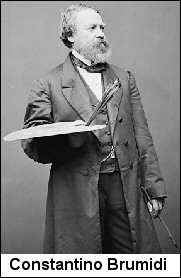 century
frescoes in the Vatican Palace century
frescoes in the Vatican Palace. Brumidi was good.
General Roothaan had determined to make him America’s
Michaelangelo. Archbishop Hughes let it be known
that Brumidi would be welcome to paint some frescoes in
churches of the New York bishopric. General Roothaan
then went about making the Vatican’s artist acceptable to American
egalitarianism.
Soon
after the Archbishop left Rome for New York, the Vatican accused Constantino
Brumidi of criminal acts. Supposedly, Brumidi had
committed crimes during his membership in the Republican
Civil Guard under Giuseppe Mazzini, the Italian Freemason
who had recently led ill-fated nationalist revolutions
against the papacy. These crimes were said to have
included (a)
refusing to fire on his Republican friends, (b) looting several
convents, and (c)
participating in a plot to destroy the Catholic Church – acts
reasonably sure to merit a hero’s welcome in Protestant America.
The Architect of the Capitol’s unpublished dossier on
Brumidi, which I was permitted to examine during 1993,
notes that “several widely divergent accounts suggest that
Constantino Brumidi himself was probably the source of at
least some of the legends.”
Vatican
justice found the artist guilty in December 1851 and
sentenced him to eighteen
years in prison. Several weeks later the sentence
was reduced to six years.
And within two months,
on March 20, Pio Nono himself quietly granted Brumidi an
unconditional pardon. General Roothaan then
placed his newly-created republican
freedom fighter on a ship bound for America.
Brumidi
arrived in New York harbor on September 18. On November 29, 1851 he
filed for state citizenship with the New York Court of
Common Pleas. Although the invite had come to paint
New York churches, there was no such work to be done
there. Instead, the Archbishop sent him to Mexico
City – by way of Washington, D.C. In Washington,
Brumidi was received by his Masonic brother Thomas Ustick Walter. For
two years Walter had been serving President Millard
Fillmore as Architect of the Capitol.
When the cornerstone for Walter's Capitol expansion plan
was laid on the Fourth of July of 1851, President Fillmore and
Commissioner of Public Buildings Benjamin B. French, who
also happened to be “Grand
Master of the Masonic fraternity,” led a colorful
ceremony. Washington’s popular National Intelligencer
reported the occasion was “welcomed by a display of
National flags and the ringing of bells from the various
churches and engine houses.”
Thomas Walter needed Constantino Brumidi. An
edifice as important as the United States Capitol-like
the palaces of Augustus and Nero, the Baths of Titus and
Livia, the Loggia of Raphael at the Vatican-required the
most noble and permanent interior decoration
possible. Only fresco painting, in which
pigments are mixed with wet mortar immediately before
application to the surface, would suffice. And only Constantino Brumidi,
of all the artists living in America, knew how to paint
fresco. But the dome was not yet ready to be
frescoed. So the artist was routed to the sunny,
Italianate climate of Mexico City to enjoy life, to ponder
his subject matter at a casual pace, to wait for the call.
Two
years later, on December
28, 1854, less than three weeks following Pio Nono’s decree of the
doctrine of Immaculate Conception, Constantino
Brumidi appeared in the office of Montgomery C. Meigs,
Supervising Engineer of the Capitol extension project.
The Capitol’s unpublished dossier on Brumidi relates that
as the two men conversed in broken French, Brumidi struck
Meigs as “a lively old man with a very red nose, either
from Mexican suns or French brandies.” The immediate
upshot of their conversation was a commission to paint
a fresco covering an elliptical arch at one end of
Meigs’ office in the Capitol. It was the first fresco ever
painted in the United States, as well as Brumidi’s first
in five years. The fresco celebrated the coming Civil War in terms of
Roman history. According to the commission’s
report it depicted “a senator, who points to Rome and
appeals to Cincinnatus to come to the help of his
country.” Cincinnatus, the fifth-century BC Roman
dictator, was called to defend Rome twice, first from
foreign invaders, then from his own common people.(civil
war) Likewise, American heroes first defended their Rome against
foreign British invaders, and were now about to
be called to defend the
same Rome against her own seceding states.
Brumidi completed the Cincinnatus in March 1855. Meigs
invited various Congressmen to behold it. They were
impressed. Thomas U. Walter was “much delighted.” On March
20, Jefferson Davis approved of the Cincinnatus and
authorized Meigs to negotiate a salaried contract with
Brumidi. Constantino Brumidi’s lifetime career spent
decorating the Capitol began on a salary of $8.00 a
day. His contract allowed him to accept other
artistic projects but not to leave Washington. In
November 1855 he began a canvas painting of the Blessed Virgin for St.
Ignatius’ Jesuit church in Baltimore, but
was not present for its December 4th installation, on
the occasion of the Feast of the Immaculate Conception.
In the summer of 1862, even
as Thomas Crawford’s statue was being cast at the Mills
foundry, Thomas U. Walter wrote to Brumidi asking
him to paint something monumental “in real fresco” to
cover the 4,664-square-foot
inner surface of the Capitol’s dome. Three
weeks later, Brumidi submitted sketches of something he
entitled “Apotheosis of
Washington.” The word “apotheosis” was then commonly understood
by its definition in Webster’s 1829 Dictionary:
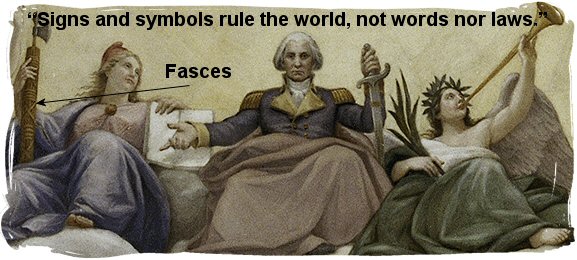
|
Apotheosis – the
act of placing a prince or other distinguished
person among the heathen deities. This honor was
often bestowed on illustrious
men of Rome, and followed by the erection of
temples, and the institution of sacrifices to the
new deity.
|
|
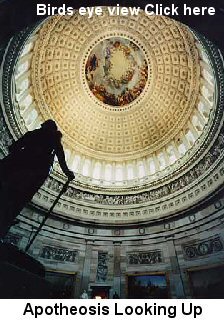 Walter responded ecstatically
to the “ Apotheosis,”
writing the artist that “ no
picture in the world will at all compare with this in
magnitude.” He praised the design before Worshipful Master and
Commissioner of Buildings Benjamin French as “ probably the
grandest, and the most imposing that has ever been
executed in the world.” French enthusiastically
agreed, adding that the Secretary of Interior was also
greatly impressed. Final approval of “ Apotheosis” at a price
of $40,000 came on
March 11 , 1863, just as the Immaculate Virgin was
being placed on her temporary pedestal on the Capitol’s east grounds. “Frustrating
delays in manpower,” according to official histories,
would hold the fresco in abeyance until December 1864.
On
April 9, 1865, Richmond fell and the Confederacy
surrendered to Ulysses S. Grant. Less than a week later,
on the evening of April 14 at Ford’s Theatre, during an
instant of hilarious laughter, one of the country’s
leading actors, John Wilkes Booth, cried out an oath
summarizing the liberation
theology of Cardinal Robert Bellarmine: “Sic Semper
Tyrannis” (“Always this [i.e., death] to
tyranny”), and fired a shot into the head of President
Abraham Lincoln. Sic Semper Tyrannis is also the motto of Virginia,
then considered a State
in rebellion. Might Booth’s cry have been
intended to give the assassination the look of an official act of the
Confederacy, much in the way Lee Harvey Oswald’s
much-touted sympathy for Cuba initially gave the Kennedy
assassination the look
of communist revenge? An illusion of official
Confederate responsibility for a beloved president’s
assassination justified the elaborately cruel revenge
which the federal government inflicted upon the southern
states in order to bring all the states under the
jurisdiction of Washington D.C. (The inferiority of states
to the federal “Rome”
is expressed in the law of flag. Wherever state and
national flags are flown
together, the national is always higher.)
Booth had associated with seven people who were
brought to trial less than
a month following the assassination. It was not a
civilian trial but a special eleven-man military tribunal
appointed by President Andrew Johnson called “The Hunter
Commission.”
Counsel for the
defendants objected to the Commission, arguing that the
military had no jurisdiction over civilians, and
therefore the proceeding was unconstitutional.
The objection was overruled and the trial moved forward.
Within seven weeks, the Commission (a two-thirds majority,
not the unanimity required of a civilian jury) found four
of the conspirators guilty. On July 7, 1865 they were
hanged.
“The great fatal mistake of the
American government in the prosecution of the assassins of
Abraham Lincoln,” wrote Rev. Charles Chiniquy, the
excommunicated priest whom Lincoln had successfully defended
in his early law career,
|
| was
to cover up the religious element of that terrible
drama. But this was carefully avoided throughout the
trial. |
|
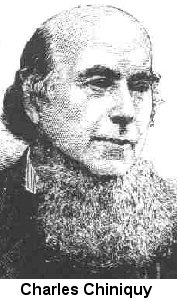 The religious element-the
fact that all seven
of the conspirators were devoted Roman Catholics-was
carefully avoided because of who controlled the trial. As
Commander-in-Chief of the armed forces, it was Johnson
himself who quite constitutionally reigned supreme over
the Hunter Commission. But Johnson was also a Freemason,
which meant that he followed the wise directives of the
Unknown Superior. Thus, the real power behind the Hunter
Commission was Superior
General Pieter Jean Beckx,(black pope 1853 to
1887) a relatively young Belgian who was a
great favorite of Pio Nono, Pope Pius IX, the only head of state
in the world to recognize the Southern Confederacy as a
sovereign nation. Obedient to the will of General
Beckx, President Johnson issued an executive order closing the
courtroom to the working press. At the end
of each day, officials would ration to selected reporters
from the Associated Press news carefully evaluated to keep
“the religious element”
out of the public consciousness.(Please
understand the power of cover-up)
Charles Chiniquy tirelessly investigated the assassination.
After the conspirators were executed, he went incognito to
Washington and found that:
|
| not
a single one of the
government men would discuss it with me
except after I had given my word of honor that I
would never mention their names. I saw, with a
profound distress, that the influence of Rome was
almost supreme in Washington. I could not
find a single statesman who would dare to face
that nefarious influence and fight it down. |
|
One
official told him: “This was not through cowardice, as you
might think, but through a wisdom you ought to approve, if
you cannot admire it.” Had there not been censorship, had
the witnesses been pressed a little further, “many priests would have been
compromised, for Mary Surratt’s [one of the four
executed conspirators] house was their common rendezvous; it
is more than probable that several of them might have been hanged.”
Thirty
years after the assassination, a member of the Hunter
Commission, Brigadier
General Thomas M. Harris, published a
small book revealing that
Lincoln’s assassination had actually been a Jesuit murder plot to
extirpate a Protestant ruler. Harris stated:
|
|
It is fact well established
that the headquarters
of the conspiracy was the house of a Roman Catholic family,
of which Mrs. Mary E. Surratt was the head; and
that all of its inmates, including a number of
boarders, were devoted
members of the Roman Catholic Church.
This house was the meeting place, the council
chamber, of Booth and his co-conspirators, including Mrs. Mary
E. Surratt, and her son, John H. Surratt, who,
next to Booth, were the most active members of
the conspiracy.
|
|
Commissioner Harris went on to relate that Mary Surratt’s
son John had been a Confederate spy for three years,
“passing back and forth between Washington and Richmond,
and from Richmond to Canada and back, as a bearer of
dispatches.” John’s mentor during this period was a Jesuit, Father B.F. Wiget,
president of Gonzaga College and a priest noted
for his sympathies for the Confederacy. John introduced Father Wiget to
his mother and the priest became Mary Surratt’s confessor
and spiritual director. As well, Father Wiget gave spiritual
direction to the famous John Wilkes Booth who,
though “a drunkard, a libertine, and utterly indifferent
to matters of religion,” was spiritually attracted to him.
“The wily Jesuit,
sympathizing with Booth in his political views,
and in the hope of destroying our government, and
establishing the Confederacy... was able to convert him to Catholicism.”
Hard evidence of that conversion was found on the
assassin’s corpse: “On examination of Booth’s person after
his death, it was found that he was wearing a Catholic
medal under his vest, and over his heart.”
At the
conspiracy trial, Father
Wiget testified to Mary Elizabeth Surratt’s “good
Christian character.” Even assuming her
complicity in the assassination, Wiget as a Jesuit could
truthfully say Surratt was a good Christian
simply by reserving mentally (a) that by
“Christian” he meant
“Roman Catholic;” (b) that under the terms of the Directorium Inquisitorum
(see Chapter 8), “Every
individual may kill a heretic;” and (c) that President
Lincoln was twice a
heretic: for his Protestantism and for his having
successfully defended an
excommunicated priest.
But Mary after all “kept the nest that hatched the egg,”
as President Johnson put it, and was hanged. Conditional
to her death sentence was a provision that a petition for
mercy would be attached and sent to Johnson. By
execution day, July 7, 1865, Surratt’s daughter Anna had
heard nothing from the President. Distraught, she
appeared at the White House to beg him for clemency. Two
government men stood in her way. Preston King and
Senator James Henry Lane denied her access to the
President, who later declared he had never received any
petition for mercy. The following November, Preston King
drowned, his body laden with weights. In March, Senator
Lane shot himself. (In the judgment of one modern
investigator, “Some person or persons were apparently
determined that Mary Surratt should not live.”) Shortly
thereafter, the Supreme Court rendered a landmark decision
that would have won all the conspirators a jury trial. Ex
parte Milligan held that military courts have no
jurisdiction over civilians. Milligan lent Mary
Surratt’s death at the hands of Protestants an aura of
tragedy and Catholic martyrdom.
Charles
Chiniquy obtained important testimony supporting the
widely held suspicion of Jesuit responsibility for the
assassination. He received from Rev. Francis A.
Conwell, Chaplain of the first Minnesota Regiment, a sworn
affidavit saying that on April 14, 1865, he was visiting
St. Joseph, Minnesota, location of a Roman Catholic
seminary. Rev. Conwell swore that at about six o’clock
that evening the man in charge of the seminary, a
storekeeper by the name of J.H. Linneman, told him and
another visitor, Mr. H.P. Bennett, that President Lincoln
had “just been killed.”
The next day, Rev. Conwell journeyed ten miles to the town
of St. Cloud. As soon as he arrived, he asked the
hotelier, Mr. Haworth, if he had heard any news of a
presidential assassination. Mr. Haworth had heard nothing,
as St. Cloud had neither railroad nor telegraph. On the
following morning, April 16th, on his way to preach a
sermon in church, Rev. Conwell was handed a copy of a
telegram brought up by stagecoach from Anoka, Minnesota.
The telegram announced that President Lincoln had been
assassinated on Friday evening at about nine o’clock.
On the
morning of Monday the 17th, Rev. Conwell hurried to St.
Paul and reported to the newspaper that in St. Joseph he
had been informed of President Lincoln’s assassination
three hours before the event took place. The paper
published his report. “We have now before us,” wrote
Commissioner Harris,
|
|
positive evidence
that these Jesuit Fathers, priests of Rome,
engaged in preparing young men for the priesthood
away out in the village of St. Joseph, in far off
Minnesota, were in correspondence with their
brethren in Washington City, and had been informed
that the plan to assassinate the President had
been matured, the agents for its accomplishment
had been found, the time for its execution had
been set, and so sure were they of its
accomplishment, that they could announce it as
already done, three or four hours before it had
been consummated. The anticipation of its
accomplishment so elated them that they could not
refrain from passing it around ... as a piece of
glorious news.
|
|
MEANWHILE, through
the Lincoln assassination and its aftermath, the Vatican’s artist,
Constantino Brumidi, along with some seventy French and
Italian assistants, applied pigmented mortar to
the interior canopy of the Capitol dome. They were still
working when the first session of the Thirty-ninth
Congress met on December 4, 1865. Not until the
following January did the scaffolding come down. When it
did, viewers were awestruck by what they beheld. Brumidi
had crowned the ceiling of America’s legislative center
with a glorious, panoramic visualization from Book VI of
Virgil’s Aeneid, where Aeneas’ blind father, Anchises,
explains NOVUS ORDO
SECLORUM:
|
|
“Here is Caesar, and all the line of Julius, all who
shall one day pass under the dome of the great sky.
This is the man, this one, of whom so often you have
heard the promise, Caesar Augustus, son of the
deified, who shall bring once again an Age of Gold
to Latium, the land where Saturn reigned in early
times. He will extend his power beyond the
Garamants [Africans] and Indians, over far
territories north and south of the zodiacal stars,
the solar way....” |
|
The
epicenter of “Apotheosis of Washington” is a
solar orb, the Sun-God
into which Augustus Caesar was said to have been absorbed
when his body died. From the Capitol’s highest
interior point Augustus radiates his golden light
outward and downward to the next in the “line of Julius,”
the deified George
Washington. The god Washington occupies the judgment seat of
heaven, sword of Justice firmly clasped in his
left hand. Basking in the light of Augustus–Pontifex Maximus(meaning the"highest"of SUN
Worship high priests) he rules “over far
territories north and south of the zodiacal stars, the
solar way.” Like his Caesarean forebears, Washington is God,
Caesar,(Pontifex maximus) Father of his Country.
On the
right hand of the Father
sits Minerva, holding the emblem of Roman totalitarianism, the
fasces. Minerva, we recall, was the virgin goddess of the
Sacred Heart–it was she
who rescued the heart of the Son of God, and
placed it with Jupiter in heaven. She was called “ Minerva” when praised
for her justice and wisdom. When praised for her beauty
and love, Minerva was known as Venus, the Queen of Heaven.
She and Venus were often identified with each other, just
as statues of both were reconsecrated “ Mary” through Roman
Catholic missionary adaptation. Minerva’s most persistent
role in ancient paganism was Dea Benigna, “The Mediatrix.”
She heard the prayers of sinful mortals and passed them on
to Jupiter, in the same way the Roman Mary is believed to pass Catholic
prayers on to Christ. 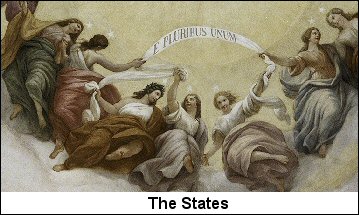
Completing the circular composition around the solarized Augustus are thirteen nubile
goddesses. These are the original
States. They dance weightlessly in space,
supporting a white banner inscribed with the soul of the
Bacchic Gospel, “E
PLURIBUS UNUM.” Above the head of each
State-goddess floats a magical white pentagram.
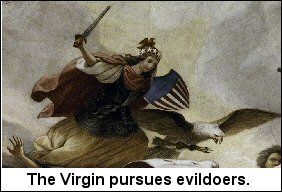 Beneath all
this celestial revelry, Brumidi painted more Roman gods
mingling with American mortals. Here is Vulcan, the god of
fire and craftsmanship, planting his foot on a cannon,
while his workers prepare munitions and weapons of death
and destruction. And over here Neptune rises with his
trident from the sea in a horse-drawn scallop-shell
chariot. And here the wise Mediatrix communicates
with American scientists Benjamin Franklin, Samuel F. B.
Morse, inventor of the Code, and Robert Fulton, inventor
of the steamship.
And here, the Goddess
Immaculately Conceived, the Dreadnaught Mary.
Wearing the pentagrams and eagle headdress of Thomas
Crawford’s statue atop the dome’s exterior, she mobilizes
her sword and shield against a pack of fleeing sinners
labeled “Tyranny” and “Kingly Power.” Jupiter’s
mascot, the Roman eagle,
glides just behind her clutching a bunch of thunderbolts
in his talons. Innocent in her flowing scarlet cape,
the Goddess is
situated exactly beneath the deified George Washington, coming between
him and the embattled viewing public gazing up from ground
level. It is the graphic realization of
Pio Nono’s Ubi primum, which decreed the Virgin Mary was
“set up between Christ and his Church, always delivering
the Christian people from their greatest calamities and
from the snares and assaults of all their enemies.”

The eagle gliding behind Mary
explains the otherwise inscrutable seal of the United
States Justice Department, which contains a wingspread
eagle surrounded by the motto “QUI PRO DOMINA JUSTITIA
SEQUITUR” (“He who follows the Goddess Justice”).
Persephone, or Minerva the Mediatrix, when judging
the sinfully dead in Hades was called Justitia, or
Justice. The “HE”
of the Justice Department’s motto identifies the eagle,
symbol of Rome. Rome
follows the Goddess Justice – that is, the
Immaculately Conceived
Mother of God in her judicial capacity.
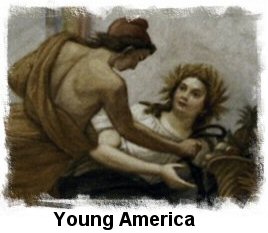 A rainbow sweeps across
the lower quadrant of the Dome of the Sky from Benjamin
Franklin to a young boy wearing a Smurf-cap and a
toga. The boy attends a goddess who reclines on a
large horse-drawn reaper. She is Persephone’s mother Ceres,
who was reconsecrated by early missionary adaptation as
Anna, mother of the Virgin Mary. The golden boy is
officially designated “ Young
America.” Although Brumidi has hidden the boy’s
face from us, he deserves our careful scrutiny for one
very important reason. Bearing the name “America,” he is
the only element in the sacred national iconography that
defines the character of the American person as perceived
by government.
Young
America’s Smurf-cap is a style of headgear known as the
“Phrygian cap.” Phrygia was a district in the Kingdom of
Per gamum. We remember Pergamum. It was the middle point
in the transfer of Babylonian religion westward to Rome.
Phrygia is a Greek word meaning “freemen” (our English
word “free” comes from the first syllable, “phry-”).
Phrygian caps were given to freed Roman slaves to indicate their new
liberated status. Roman
law regards liberty as a conditional status. Once
granted by a patron, it could be revoked at any time for
cause. Phrygian-cap freedom, then, means liberty
(freed Roman slaves, by the way, were called “liberti”) to
please Caesar. We remember from Chapter 8 how Ignatius described such
freedom in Section 353.1 of his Exercises: “We must
put aside all judgment of our own, and keep the mind ever
ready and prompt to obey in all things the hierarchical
Church.” Of course, those liberti bold enough to protest
what their superiors commanded lost their freedom, no
matter how lucid and reasonable their own judgment might
have been. They were reverted to slavery. Since the advent
of the Febronian State Church, the reversion of protestant
liberti, or Protestants, to slavery has been so methodically insidious that
it’s hardly noticeable. The shackles are
psychological, humanely fitted by increasing varieties of
spiritual exercise. Like Aeneas, Anchises, Julius Ascanius
and their Trojan followers, most Americans are indeed
Phrygiancap freemen, free
to sacrifice their individuality to the greater glory of
Rome.
The
Black Obelisk of Calah, which stands in the
Babylonian-Assyrian Wing of the British Museum, records
the great accomplishments of the ninth-century BC god-king
Shalmaneser II. In a scene depicting various monarchs
paying obeisance to Babylon, we see one monarch kneeling
before Shalmaneser, worshiping him. Shalmaneser in turn
offers a sacrifice to an eight-pointed star set within a
bird’s wings and tail-feathers. Inscriptions identify this
kneeling monarch as King Jehu of Israel. Remarkably,
according to the New Catholic Encyclopedia, Jehu’s
likeness here is the only known contemporaneously-rendered
portrait of a biblical personage. More remarkably,
Jehu is wearing the Phrygian cap. Like BrumidiYoung
America, Jehu’s liberty is subject to the mood of his
god-king.
The
Bible confirms the testimony of the Black Obelisk. At II
Kings 10:31 we read: “Jehu took no heed to walk in the law
of the Lord God of Israel with all his heart.” Scripture
further tells us that THE FREEDOM CAP Jehu submitting to
Shalmaneser Jehu worshiped the golden calf, a sacred
Babylonian icon made fashionable in tenth-century-BC
Israel by Jehu’s predecessor,  Jeroboam. Jeroboam
renounced “the law of the Lord G o d of Israel” and
instituted... democracy. Democracy opened the Israelite
priesthood, originally appointed by Yahweh exclusively to
the family of Levi, to all applicants. Consequently,
Yahweh’s priesthood was infiltrated by non-believers and
foreign sympathizers. They prepared the way for Jehu to
make of himself a Phrygian freeman, obligated to concur
with obedience of the understanding in all things which
his superior, Shalmaneser II, commanded – exactly as the
Black Obelisk explains in lucid visual terms. As a
direct result of Jehu’s departure from the God of Israel,
the Israelite nation began falling apart. It was
ultimately destroyed by Caesarean Rome, the legitimate
heir to Shalmaneser’s Babylonian authority as it passed
down through Pergamum.
Running throughout this cosmic Battle of the Faiths is a
highly refined cabalah involving the concept of “golden
calf.” The word “calf” in Hebrew, the language of Jehu and
Jeroboam, is MCS, pronounced “eagle.” Whereas Jehu gave
his people Shalmaneser’s golden MCSi to worship, the
Church Militant has trained the American public to worship
Rome’s golden eagle,
which surmounts every flagpole. Could it be that if
we show respect, affection, or loyalty toward the national eagle we
create the presumption of worshiping the golden calf, and so
alienate ourselves from the God of the Bible and in the
vacuum find ourselves under the rule of the Church Militant?
ACCORDING to J.C.
Judson, in his Biography of the Signers of the Declaration
of Independence, as General Washington was planning his
famous expedition against Cornwallis at Yorktown, “the
army was destitute, the government treasury was empty, her
credit shivering in the wind.” Suddenly, a miracle
in the annals of philanthropy occurred. Robert Morris,
Superintendent of Finance, the highest officer in the
United States under the Articles of Confederation(1781),
personally raised eighty cannons and a hundred pieces of
field artillery. In addition, he raised “all other
necessary supplies not furnished from other sources” and
became personally
|
| responsible
to the amount of $1,400,000 upon his own notes,
which were promptly paid at maturity. This enabled
the American army to give the finishing stroke to
the revolution, and triumph, in victory complete,
over a proud and merciless foe. |
|
 So goes
a historian’s version of how Robert Morris saved America. The official
version is revealed in Constantino Brumidi’s “ Apotheosis of Washington.”
Here we see Superintendent Morris gazing up from his
accounts ledger at yet another Roman deity. We
recognize the deity from the familiar caduceus in his
right hand, from the winged sandal he’s thrust to within
kissing distance of Morris’ lips, and from the shadowy bag
of gold he tantalizingly dangles in Morris’ face. The
deity is Mercury, the Psychopomp, the
Trickster, the patron deity of commerce, deceivers, and thieves.
Mercury, the brilliant, lovable Pied-Piper deity who
deceives the souls of sinful humanity into following him
exuberantly down into the oblivion of Hades. Just as Sebastiano
Ricci’s painting subtly established Mercury as the
guiding spirit of modern Roman Catholicism, Brumidi’s
painting acknowledges the
same deity’s ascendancy over the fulfillment of the
American Revolution.
Amazing stuff, these pictures. And like so many of the
testimonies presented in this book–the supremacy of the Church
Militant, the publication of Sun-Tzuan strategies
in a western language, the names, the numbers, the dates, the locus
and layout of the federal city, the architecture, the
statuary, the monuments, the emblems, the frescoes, the
ceremonies–they come not from the Trickster’s victims,
but from the Trickster
himself. It’s as if the point of the trick is to
warn the victim
beforehand, in words and pictures, that he or she
is about to be tricked. A con is much
sweeter when the mark actually consents to the con. That
way, the Trickster’s conscience is clear.
CONSTANTINO Brumidi
continued decorating the Dome of the Great Sky well into
his seventies. In 1879, at the age of 74, while
painting “Penn’s Treaty with the Indians” on the Rotunda
frieze, he slipped from a scaffold. Dangling fifty-eight
feet from the marble floor, he held on until help came. He
escaped a deadly fall. But the shock of the
experience killed him a few months later.
|
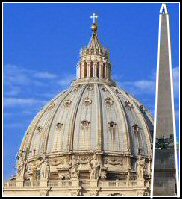
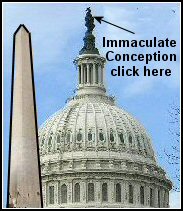
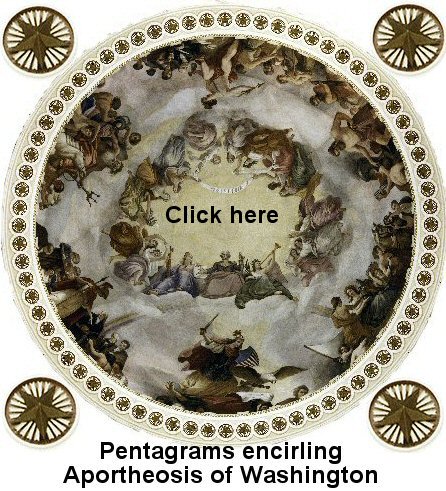



 The
The 
 Beneath all
this celestial revelry, Brumidi painted more Roman gods
mingling with American mortals. Here is Vulcan, the god of
fire and craftsmanship, planting his foot on a cannon,
while his workers prepare munitions and weapons of death
and destruction. And over here Neptune rises with his
trident from the sea in a horse-drawn scallop-shell
chariot. And here the wise Mediatrix communicates
with American scientists Benjamin Franklin, Samuel F. B.
Morse, inventor of the Code, and Robert Fulton, inventor
of the steamship.
Beneath all
this celestial revelry, Brumidi painted more Roman gods
mingling with American mortals. Here is Vulcan, the god of
fire and craftsmanship, planting his foot on a cannon,
while his workers prepare munitions and weapons of death
and destruction. And over here Neptune rises with his
trident from the sea in a horse-drawn scallop-shell
chariot. And here the wise Mediatrix communicates
with American scientists Benjamin Franklin, Samuel F. B.
Morse, inventor of the Code, and Robert Fulton, inventor
of the steamship. 
 A rainbow sweeps across
the lower quadrant of the Dome of the Sky from Benjamin
Franklin to a young boy wearing a Smurf-cap and a
toga. The boy attends a goddess who reclines on a
large horse-drawn reaper. She is
A rainbow sweeps across
the lower quadrant of the Dome of the Sky from Benjamin
Franklin to a young boy wearing a Smurf-cap and a
toga. The boy attends a goddess who reclines on a
large horse-drawn reaper. She is  Jeroboam. Jeroboam
renounced “the law of the Lord G o d of Israel” and
instituted... democracy. Democracy opened the Israelite
priesthood, originally appointed by Yahweh exclusively to
the family of Levi, to all applicants. Consequently,
Yahweh’s priesthood was infiltrated by non-believers and
foreign sympathizers. They prepared the way for Jehu to
make of himself a Phrygian freeman, obligated to concur
with obedience of the understanding in all things which
his superior, Shalmaneser II, commanded – exactly as the
Black Obelisk explains in lucid visual terms. As a
direct result of Jehu’s departure from the God of Israel,
the Israelite nation began falling apart. It was
ultimately destroyed by Caesarean Rome, the legitimate
heir to Shalmaneser’s Babylonian authority as it passed
down through Pergamum.
Jeroboam. Jeroboam
renounced “the law of the Lord G o d of Israel” and
instituted... democracy. Democracy opened the Israelite
priesthood, originally appointed by Yahweh exclusively to
the family of Levi, to all applicants. Consequently,
Yahweh’s priesthood was infiltrated by non-believers and
foreign sympathizers. They prepared the way for Jehu to
make of himself a Phrygian freeman, obligated to concur
with obedience of the understanding in all things which
his superior, Shalmaneser II, commanded – exactly as the
Black Obelisk explains in lucid visual terms. As a
direct result of Jehu’s departure from the God of Israel,
the Israelite nation began falling apart. It was
ultimately destroyed by Caesarean Rome, the legitimate
heir to Shalmaneser’s Babylonian authority as it passed
down through Pergamum. So goes
a historian’s version of how
So goes
a historian’s version of how